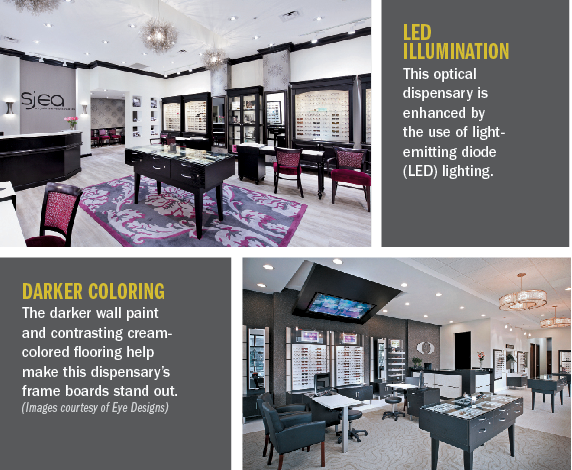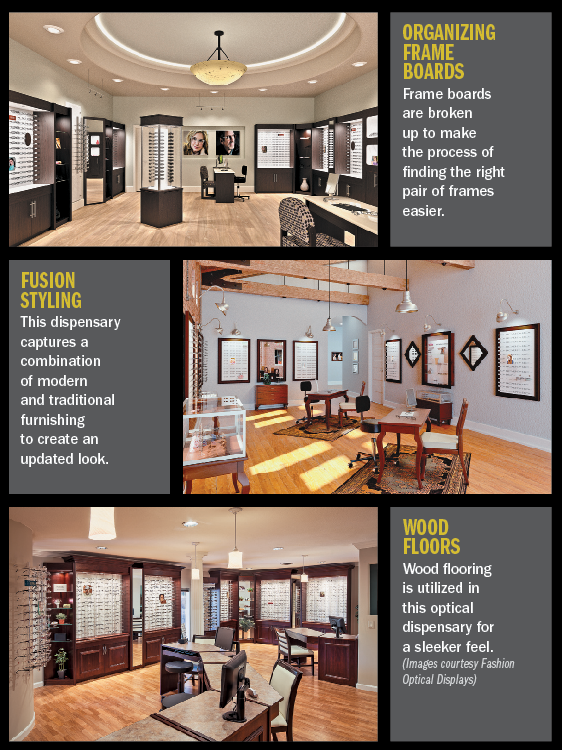Article
Trending now: Optical dispensary designs, furnishings
Optical dispensary designers discuss what they have seen this year as far as lighting, fixture plans, visual merchandising, and color scheme trends.
Take Home
Optical dispensary designers discuss what they have seen this year as far as lighting, fixture plans, visual merchandising, and color scheme trends.
By Rose Schneider, Content Specialist, Ophthalmology Times
The design and functionality of an optical dispensary are highly important aspects to an ophthalmologist’s practice, but choosing ideal color schemes and fixture plans that will optimize patients’ experience is key.
While there are endless options from which to choose, Dan Sloan-a designer for Fashion Optical Displays, Paradise, CA-said he has recently seen a shift to light-emitting diode (LED) lighting, hardwood flooring, color and furniture schemes that are a mix between traditional and contemporary, and a focus on improving merchandise display organization.
LED lighting

“Lighting is now becoming a crucial component of the optical design,” said Melanie Nicholson, an interior designer for Eye Designs, Collegeville, PA. “Proper illumination of the optical (dispensary) can affectively change the mood of the space.”
In the past, Sloan said LED lighting was less common than standard halogen lighting because it had high Kelvin ratings, which caused light fixtures to look “awfully funny” in the dispensaries, almost emitting a purplish color.
But with growing technology over the years, he said, LED lighting now produces “that nice warm glow,” similar to halogen lighting, but uses less energy and produces less heat.
More physicians are requesting decorative chandeliers, scones, and frame displays with LEDs as well, Nicholson added.
“Using the proper LED lighting can really make the frames and brands that you’re featuring pop, drawing customers in and grabbing their attention,” she said.
Flooring
Both Sloan and Nicholson said physicians have begun to lean more toward wood flooring, as opposed to traditional carpeting.
“Hard surfaces make it look more high-end,” Nicholson said.
Flooring color requests have begun to shift toward the dark end of the scale, Sloan said, such as darker stain or espresso coloring, to add more of a contrast between display fixtures and the floor.
“That seems to be trending pretty heavily,” Sloan said.
To accomplish the same outcome, Nicholson said she has seen requests leaning toward grays and neutral creams, which are accented by the now trending splash of color that can be seen incorporated in seating, imagery, and tile in the practice’s reception area.
However, some physicians are opting for wood plank ceramic tile or vinyl plank over hardwood flooring, Nicholson noted, due to pricing.

Furniture, organization
Frame boards have had a complete overall, as physicians are now realizing that-to make the process of finding the right pair of frames easier for patients-organization is of the upmost importance.
“Merchandising elements are key to letting your customers know what you are selling and the brands that you carry,” Nicholson said. “It is so frustrating to walk into a doctor’s practice and see a wall of frames. Frame boards need visual breaks so the eye can rest and give direction to the frames that are meant for them.”
Nicholson suggested adding small signage within the frame board to help distinguish gender, styles, and brands.
Joost Bende, president and principal architect for Pacific 33 Architects Inc., San Diego, said he has seen a shift toward opting out of frame boards completely, and instead using glass shelves or other unique displays to help the products stand out to patients.
If the physician would like to stick with frame boards, Sloan suggested breaking up the boards with shelving or putting the frames into collections, which would create better ease for patients.
Feature walls have also become quite popular, according to Nicholson, along with areas to incorporate large LED televisions, new products, and brand merchandising.
“Offices are adding three-dimensional wall dividers with cutout to create a unique look,” she added.
Updating the optical dispensary’s overall look to be more up-to-date visually has been a common theme seen by Sloan, Nicholson, and Bende.
“Overall designs of the office are becoming less clinical and more retain driven,” Nicholson said. “People are looking for the cool factor in the design of a new space with more of a contemporary feel.”
Bende added that he has seen the trend moving toward a “very modern look, linear and simple,” while Sloan said he has seen more combinations of old and new.
“(They) aren’t purely traditional or contemporary, but a fusion of the two,” he said.
Subscribe to Ophthalmology Times to receive the latest clinical news and updates for ophthalmologists.
Newsletter
Don’t miss out—get Ophthalmology Times updates on the latest clinical advancements and expert interviews, straight to your inbox.




